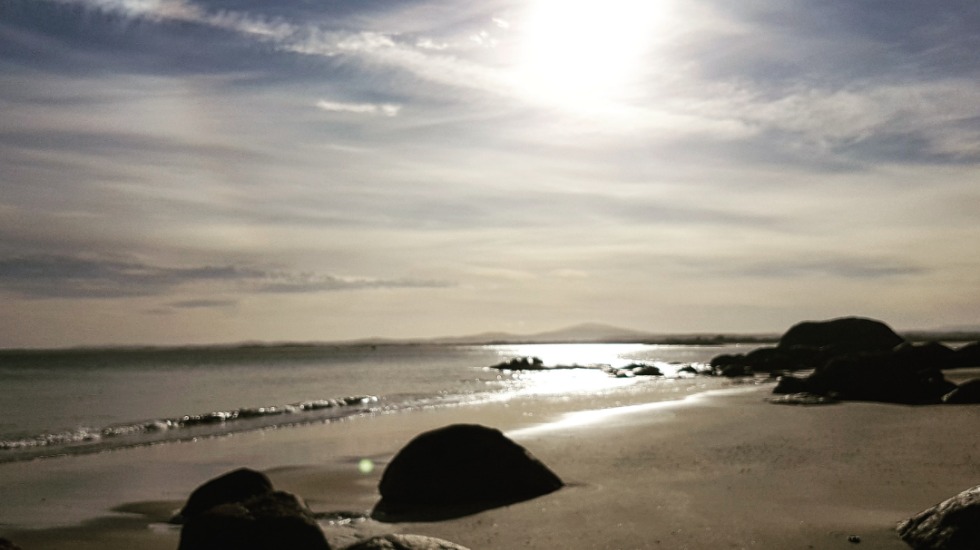For the past 30 months I have swum in an ocean, my head bobbing above the water line, have felt the splash and thud of waves, the sting of salt, the dragging further out from land, the nursing back to shore, the ebb and flow of heartache. The ocean is a part of me.
So now, the ocean has a name: prolonged grief disorder. Its depths, its shoals, its islands within it, its breadth, its currents, its horizons. Prolonged grief disorder.
My state of heart has been diagnosed, courtesy of the American Psychiatric Association. Not specifically, of course. But on general terms, it’s in a state of disorder. Except, it’s not. Its state is the natural flow of love, the river of life, where all life flows, to the ocean.
All of us carry within their own particular ocean when they are intimately touched by a death, especially the death of a child.
In October 2019 my son Hamish died. He was 21. His loss is my ocean. His life, like a river, ran through mine. I grieve him now, as I did from the first second of his passing; the shape of the grief changing as time goes on. I will grieve him always for where once there was his life in mine, now there is his death. It’s not a prolongation, as if there is a clock calling time on appropriate exercising of mourning.
How do you measure such things, by callipers, ultrasounds, x-rays, electrocardiograms, blood samples?
According to the association’s Diagnostic and Statistical Manual of Mental Disorders (DSM-5), which was released recently, people who are still grieving a year after the loss, and are unable to walk back into their daily life, as it was before the death, have prolonged grief disorder.
A report in The New York Times says that with the diagnosis now in the DSM-5, doctors who are treating people with the disorder can invoice insurance companies. It will also lead, of course, to a race by pharmaceutical companies to provide medication to treat it.
Naltrexone, which is prescribed, among other uses, to block the effects of heroin, is being tested clinically as grief therapy. Naltrexone’s side effects might include anxiety and sleep problems.
PLEASE HELP US CONTINUE TO THRIVE BY BECOMING AN OFFICIAL FOOTYOLOGY PATRON. JUST CLICK THIS LINK.
The Times report quotes Joanne Cacciatore, an associate professor at Arizona State University, who has written on grief. She is wary of the move. “I completely, utterly disagree that grief is a mental illness. When someone who is a quote-unquote expert tells us we are disordered and we are feeling very vulnerable and feeling overwhelmed, we no longer trust ourselves and our emotions.
“To me, that is an incredibly dangerous move, and short-sighted.”
Dangerous, and deaf to the murmurings of the soul, that is the essence of being human. To give it a label, a disorder, is to give it the stain of abnormality. Something that needs to be cleansed. It says, for you to live, to move on, you must disinfect yourself.
Paul Appelbaum, chairman of the committee that oversaw the inclusion of the diagnosis in DSM-5, put it like this: the people recognised as having such a disorder “were the widows who wore black for the rest of their lives, who withdrew from social contacts and lived the rest of their lives in memory of the husband or wife who they had lost. They were the parents who never got over it, and that was how we talked about them. Colloquially, we would say they never got over the loss of that child”.
Indeed, Mr Appelbaum. Indeed.
Grief, surely, is part of the order of life and death. To consider it as akin to a pathology is wrong in every way you look at it. Take grief out of the landscape that is left after you have lost someone you love, and what is left? The barren earth, the sky without hope. To lament is to love, even when the object of that love has gone. This is grieving. It is not a disorder of the mind.
To go down that path would be akin to creating a pathology of grief.
Many cultures over centuries have brought grief into their way of life, into their rituals. It is a grain of their human harvest, a thread of their tapestry. In Mexico, there is a celebration called the Day of the Dead, a three-day festival where the departed are welcomed back. It is held every year.
This is how the Royal College of Pathologists of Australasia defines pathology: “Pathology is the medical specialty concerned with the study of the nature and causes of diseases.”
Grief is not a disease. Grief is the ocean. It is Hamish, his life and death writ in water.
It is love remembered. Apologies to EE Cummings, I carry his heart with me (I carry it in my heart) I am never without it.












Why do I love Twitter? Because people tweet about amazing things. In this case Warwick’s profound and prolonged grief about the death of his son Hamish, and research about prolonged grief which I will follow up. Thank you Warwick.